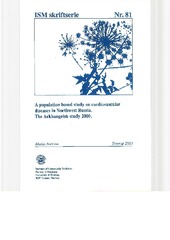A population based study on cardiovascular diseases in Northwest Russia : the Arkhangelsk study 2000
Permanent link
https://hdl.handle.net/10037/25842Date
2005Type
Doctoral thesisDoktorgradsavhandling
Author
Averina, MariaAbstract
This study was designed and carried out in Arkhangelsk to investigate reasons for high CVD
mortality/morbidity in Northwest of Russia. It revealed that the high CVD morbidity and
mortality in this population could not be explained only by the classical CVD risk factors
(blood pressure, serum lipids, smoking). Lipid profile was especially favorable. These results
from the Arkhangelsk study are consistent with findings from other studies in Russia.
High alcohol consumption, psychosocial distress and poor nutrition with low intake of fresh fruits/vegetables emerged as more important factors than the classical CVD risk factors. A substantial part of this population had hazardous or harmful level of alcohol consumption, mainly in the form of binge vodka drinking. Vodka consumption showed a linear positive association with marker of inflammation — hsCRP, which is a known indicator of CVD risk. The study population had also high levels of GGT a serum marker of high alcohol consumption. GGT levels in both sexes were more than twice as high as found in comparable studies from other countries. Participants with high GGT levels had higher risk score for CVD. Alcohol consumption was an important risk determinant for non-fatal stroke, and showed a non-significant tendency for positive association with CVD-death.
A large part of the study population reported psychosocial distress (depression, anxiety and sleeping problems) and poor nutrition with 10w consumption of fruits/vegetables. Psychosocial distress was strongly associated with low socioeconomic status, poor nutrition and high alcohol consumption, as well as with CVD. Low fruits/vegetables consumption was independently associated with CVD death. These findings underline the importance of psychosocial and nutritional variables for CVD epidemiology in Russia.
High prevalence of psychosocial distress, poor nutrition and high alcohol consumption probably reflects the high level of individual poverty in this population. In a society experiencing large socioeconomic problems these factors probably act in chain. Our results indicate that the combination of these factors may play a major role in the CVD epidemic in post-soviet Russia.
High alcohol consumption, psychosocial distress and poor nutrition with low intake of fresh fruits/vegetables emerged as more important factors than the classical CVD risk factors. A substantial part of this population had hazardous or harmful level of alcohol consumption, mainly in the form of binge vodka drinking. Vodka consumption showed a linear positive association with marker of inflammation — hsCRP, which is a known indicator of CVD risk. The study population had also high levels of GGT a serum marker of high alcohol consumption. GGT levels in both sexes were more than twice as high as found in comparable studies from other countries. Participants with high GGT levels had higher risk score for CVD. Alcohol consumption was an important risk determinant for non-fatal stroke, and showed a non-significant tendency for positive association with CVD-death.
A large part of the study population reported psychosocial distress (depression, anxiety and sleeping problems) and poor nutrition with 10w consumption of fruits/vegetables. Psychosocial distress was strongly associated with low socioeconomic status, poor nutrition and high alcohol consumption, as well as with CVD. Low fruits/vegetables consumption was independently associated with CVD death. These findings underline the importance of psychosocial and nutritional variables for CVD epidemiology in Russia.
High prevalence of psychosocial distress, poor nutrition and high alcohol consumption probably reflects the high level of individual poverty in this population. In a society experiencing large socioeconomic problems these factors probably act in chain. Our results indicate that the combination of these factors may play a major role in the CVD epidemic in post-soviet Russia.
Publisher
Universitetet i TromsøUniversity of Tromsø
Series
ISM skriftserie Nr. 81, 2005Metadata
Show full item recordCollections
- ISM skriftserie [161]
Copyright 2005 The Author(s)


 English
English norsk
norsk